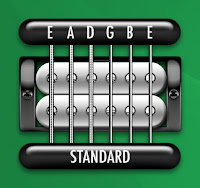Sometimes changing the tuning of a guitar from standard to some alternate tuning can create a different sound that really makes a song sparkle or a guitar stand out from the track. In this excerpt from The Ultimate Guitar Tone Handbook, we'll take a look at the different types of tunings available as well as provide a few examples on songs that you've probably heard before.
"Like an electric, the standard tuning for an acoustic guitar is E-A-D-G-B-E (low to high), where the pitch of each note is referenced to a standard pitch (A = 440.0Hz). However, the guitar is an easy instrument to change tunings with in order to create a whole new palate of sonic possibilities. These tunings can be placed into several subcategories, such as open tunings, lower tunings, higher tunings, dropped tunings and double drop tunings.
Open Tunings
Open tunings allow the guitarist to play a chord without any fretting, and has long been a favorite of the blues greats, especially those specializing in the slide guitar. You’ve heard Open G tuning, D-G-D-G-B-D, on many of the Rolling Stones hits including "Start Me Up," "Brown Sugar" and "Honkey Tonk Women." It was also a favorite tuning of Mississippi Delta bluesmen Son House, Charlie Patton and Robert Johnson.
Open A tuning, E-A-C#-E-A-E, was famously used by The White Stripes on "Seven Nation Army" (although that’s not acoustic), and Open D, D-A-D-F#-A-D, is favored by 60’s folk giant Richie Havens.
Another popular tuning, D-A-D-G-A-D, is sometimes called D modal or Celtic tuning. You’ve heard it on Led Zeppelin’s "Kashmir" and "Black Mountainside," and the Doobie Brothers’ "Black Water."
Drop Tunings
Drop tunings lower just the 6th string of the standard tuning, with Drop D being one of the most popular. Drop D is tuned as D-A-D-G-B-E and is used by Soundgarden ("Spoonman"), Creed ("Higher"), Radiohead ("Optimistic") and Led Zeppelin ("Moby Dick"). Drop C, C-G-C-F-A-D, would be a full step down from Drop D.
With double drop tunings, the 1st and 6th strings are dropped a full step, so Double Drop D is laid out as D-A-D-G-B-D. This was used by Neil Young on his hits "Cinnamon Girl," "When You Dance," "The Loner" and Crosby, Stills, Nash and Young’s "Ohio." Double Drop C, C-G-C-F-A-C, is a full step down from Double Drop D.
Lower Tunings
With lower tunings, all six strings are tuned down. An Eb tuning drops each string down a half-step and has been very popular with some of the greatest guitar players of our time such as Edward Van Halen, Stevie Ray Vaughn, Jimi Hendrix and Slash.
D tuning, D-G-C-F-A-D, where each string is tuned down a full step, is a favorite of John Fogarty, Dream Theater and the Nirvana hit "Come As You Are."
C tuning would be down two full steps to C-F-Bb-Eb-C-G, and has been used by Queens of the Stone Age and other metal bands. Tunings even lower are favored by Swedish death metal bands, but string tension will be quite low on some of these tunings, causing tuning and intonation problems.
High Tunings
Higher tunings, which are not used as much with acoustic guitars, will increase the string tension. F# tuning would be one full step up from standard with the strings at F#-B-E-A-C#-F# and G tuning (also sometimes called Third tuning) is G-C-F-A#-D-G. Not all acoustic instruments can handle these tunings, so it might be better to use a capo instead."
To read additional excerpts on this and my other books, check out the excerpts page on my website.



1 comment:
Great reference, thanks Bobby.
For any other guitarists out there, prepare to be amazed by the Boss GP-10 on the Boss US website, and the Boss GP-10 Demo by Glenn DeLaune on YouTube.
I've had this incredibly versatile unit for several months now and not only does it give any alternate tunings one could ever want (or even create) the acoustic guitar modelings for a Martin, Taylor, Gibson, etc. is the best available.
Saves a lot of time and effort having any alternate tuning available at the press of a footswitch...
Post a Comment